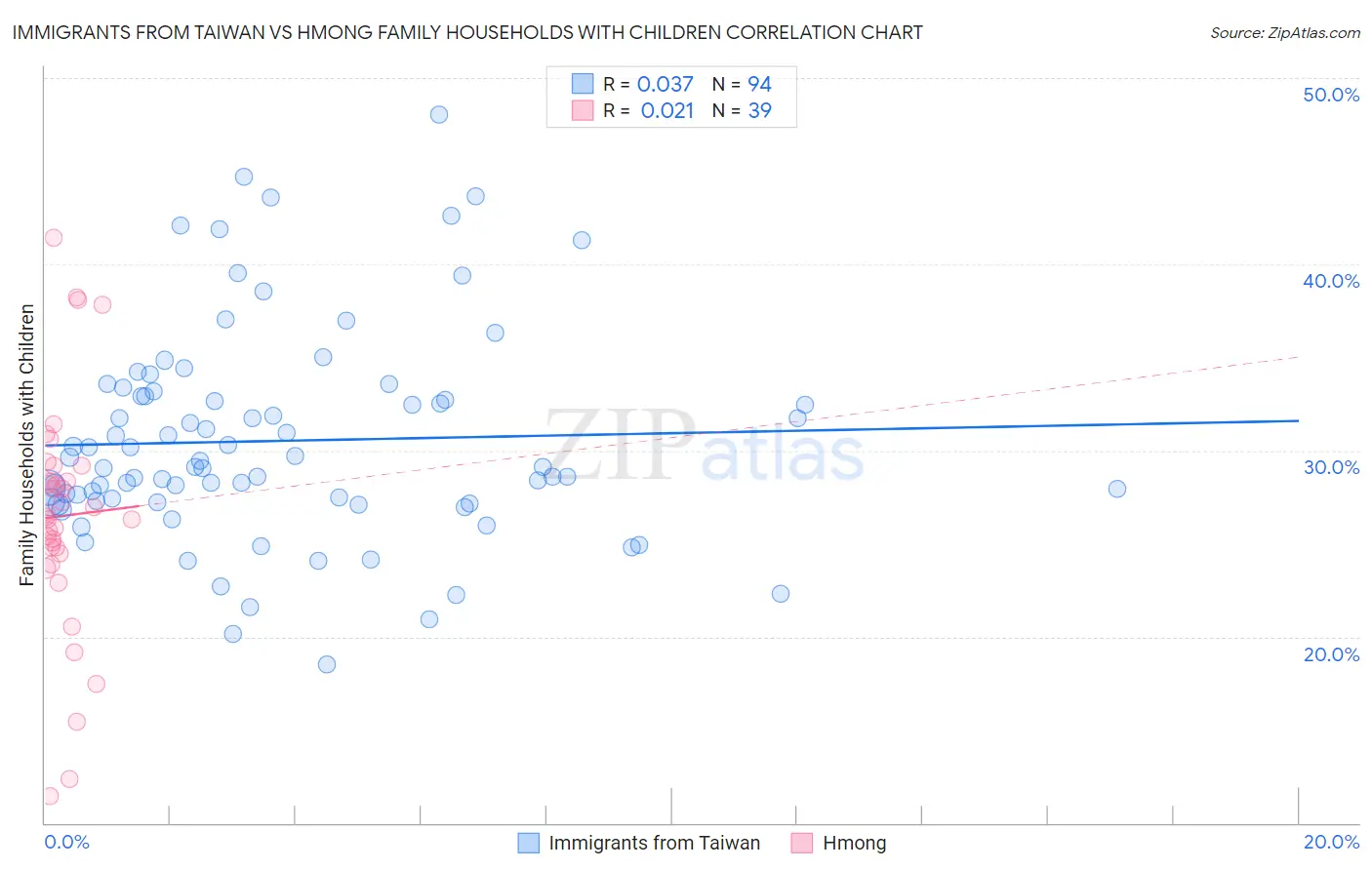Immigrants from Taiwan vs Hmong Family Households with Children
COMPARE
Immigrants from Taiwan
Hmong
Family Households with Children
Family Households with Children Comparison
Immigrants from Taiwan
Hmong
29.0%
FAMILY HOUSEHOLDS WITH CHILDREN
100.0/ 100
METRIC RATING
44th/ 347
METRIC RANK
28.6%
FAMILY HOUSEHOLDS WITH CHILDREN
99.9/ 100
METRIC RATING
60th/ 347
METRIC RANK
Immigrants from Taiwan vs Hmong Family Households with Children Correlation Chart
The statistical analysis conducted on geographies consisting of 298,050,529 people shows no correlation between the proportion of Immigrants from Taiwan and percentage of family households with children in the United States with a correlation coefficient (R) of 0.037 and weighted average of 29.0%. Similarly, the statistical analysis conducted on geographies consisting of 24,678,157 people shows no correlation between the proportion of Hmong and percentage of family households with children in the United States with a correlation coefficient (R) of 0.021 and weighted average of 28.6%, a difference of 1.6%.

Family Households with Children Correlation Summary
| Measurement | Immigrants from Taiwan | Hmong |
| Minimum | 18.5% | 11.4% |
| Maximum | 48.1% | 41.4% |
| Range | 29.6% | 30.0% |
| Mean | 30.5% | 26.5% |
| Median | 29.1% | 26.4% |
| Interquartile 25% (IQ1) | 27.2% | 24.5% |
| Interquartile 75% (IQ3) | 32.9% | 29.2% |
| Interquartile Range (IQR) | 5.7% | 4.7% |
| Standard Deviation (Sample) | 5.7% | 6.3% |
| Standard Deviation (Population) | 5.7% | 6.2% |
Demographics Similar to Immigrants from Taiwan and Hmong by Family Households with Children
In terms of family households with children, the demographic groups most similar to Immigrants from Taiwan are Asian (29.1%, a difference of 0.040%), Fijian (29.0%, a difference of 0.060%), Immigrants from Philippines (29.0%, a difference of 0.14%), Peruvian (29.0%, a difference of 0.15%), and Apache (29.0%, a difference of 0.18%). Similarly, the demographic groups most similar to Hmong are Immigrants from Nigeria (28.6%, a difference of 0.060%), Immigrants from Ghana (28.6%, a difference of 0.070%), Egyptian (28.6%, a difference of 0.080%), Hawaiian (28.7%, a difference of 0.39%), and Danish (28.7%, a difference of 0.53%).
| Demographics | Rating | Rank | Family Households with Children |
| Spanish American Indians | 100.0 /100 | #42 | Exceptional 29.1% |
| Asians | 100.0 /100 | #43 | Exceptional 29.1% |
| Immigrants | Taiwan | 100.0 /100 | #44 | Exceptional 29.0% |
| Fijians | 100.0 /100 | #45 | Exceptional 29.0% |
| Immigrants | Philippines | 100.0 /100 | #46 | Exceptional 29.0% |
| Peruvians | 100.0 /100 | #47 | Exceptional 29.0% |
| Apache | 100.0 /100 | #48 | Exceptional 29.0% |
| Jordanians | 100.0 /100 | #49 | Exceptional 29.0% |
| Immigrants | Immigrants | 100.0 /100 | #50 | Exceptional 28.9% |
| Immigrants | Peru | 100.0 /100 | #51 | Exceptional 28.9% |
| Guatemalans | 100.0 /100 | #52 | Exceptional 28.9% |
| Immigrants | Cambodia | 100.0 /100 | #53 | Exceptional 28.9% |
| Sierra Leoneans | 100.0 /100 | #54 | Exceptional 28.9% |
| Immigrants | Asia | 100.0 /100 | #55 | Exceptional 28.8% |
| Immigrants | Guatemala | 100.0 /100 | #56 | Exceptional 28.8% |
| Danes | 100.0 /100 | #57 | Exceptional 28.7% |
| Hawaiians | 100.0 /100 | #58 | Exceptional 28.7% |
| Immigrants | Nigeria | 100.0 /100 | #59 | Exceptional 28.6% |
| Hmong | 99.9 /100 | #60 | Exceptional 28.6% |
| Immigrants | Ghana | 99.9 /100 | #61 | Exceptional 28.6% |
| Egyptians | 99.9 /100 | #62 | Exceptional 28.6% |